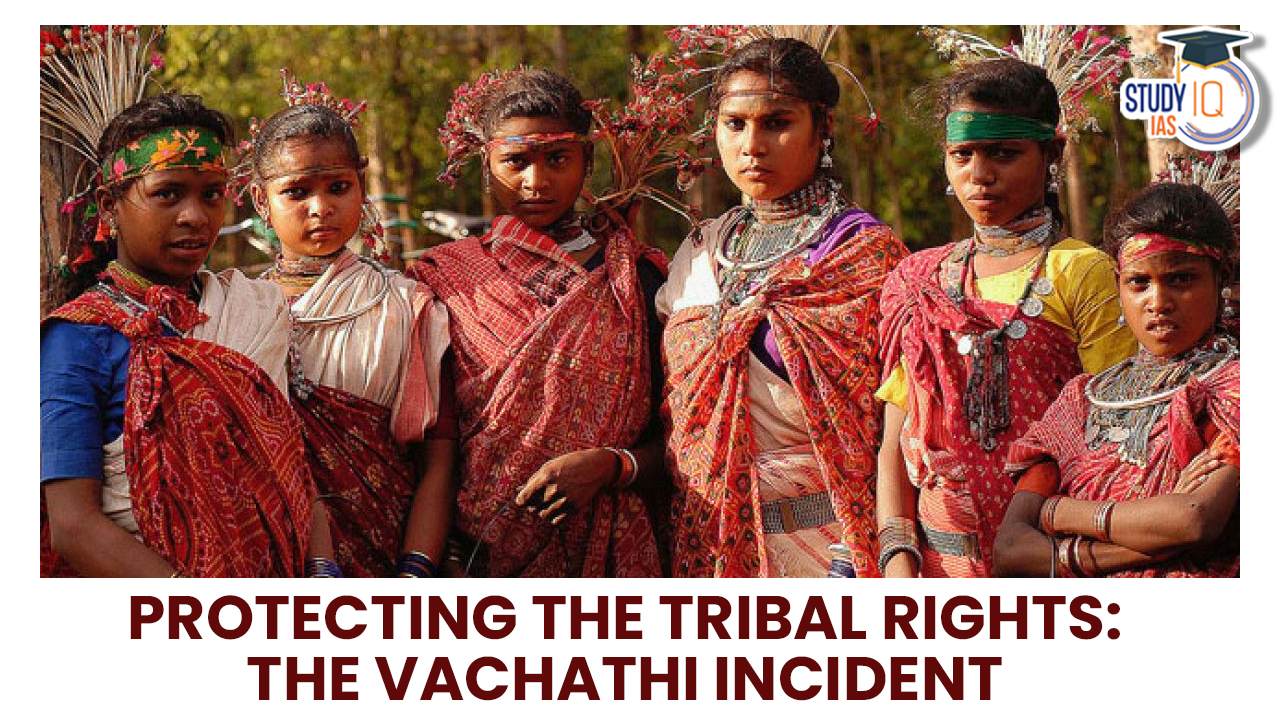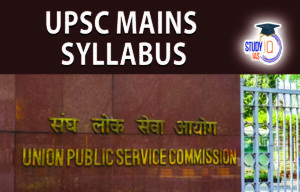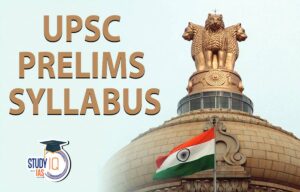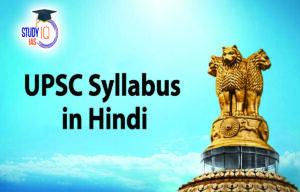Table of Contents
Context: In a landmark ruling, the Madras High Court dismissed all appeals and upheld a sessions court order which had held 215 people including all officials of forest, police and revenue departments guilty of atrocities, during their 1992 raid in Vachathi village of Tamil Nadu.
More on News:
The Vachathi Incident:
- The Vachathi incident was a tragic event that occurred on June 20, 1992, in the remote village of Vachathi, inhabited by Adivasis (scheduled tribes) in Dharmapuri district of Tamil Nadu.
- Around 300 uniformed officials, including revenue officers, police officials, and forest officials, unleashed violence on the villagers who were predominantly tribes under the pretext of unearthing smuggled sandalwood.
- This incident involved unjust and violent acts of rape and illegal confinement of children and men in the Forest Ranger’s office with some even forced to flee to the forests.
- Despite efforts by activists and organizations, justice was delayed for the victims due to the state’s refusal to provide relief, false cases filed against innocent villagers, and various legal obstacles, including opposition to public interest litigation by the state.
- The case remained unresolved for several years until the Madras High Court’s judgement on September 29, 2023.
Landmark Judgement by the Court:
- The case remained unresolved for several years until the Madras High Court’s judgement on September 29, 2023.
- In its historic judgement, the Madras High Court upheld the human rights of the people of Vachathi.
- It recognized that the coordinated and large-scale repression by uniformed forces could not have occurred without orders from or complicity at the top levels of the government.
- The court convicted all 215 accused including government and law enforcement personnel, of offences under The Scheduled Castes and Scheduled Tribes (Prevention of Atrocities) Act, 1989, and the Indian Penal Code.
- Rigorous imprisonment ranging from one to 10 years with fines was imposed.
- Additionally, the state was ordered to pay enhanced compensation of ₹10 lakh and provide jobs for each rape survivor.
Understanding the Tribal Population of India:
Who are the tribal people?
- According to the Imperial Gazetteer of India, a tribe is a collection of families bearing a common name, speaking a common dialect, and occupying or professing to occupy a common territory.
- After Africa, India has the second largest concentration of tribal population in the world.
- As per the 2011 Census, the tribal population constitutes about 8.9% of the total population in India.
Scheduled Tribes (STs):
- Article 366 (25) defined scheduled tribes as “such tribes or tribal communities or parts of or groups within such tribes or tribal communities as are deemed under Article 342 to be Scheduled Tribes for the purposes of this constitution”.
- The criteria for specification of a community, as scheduled tribes, are indications of primitive traits, distinctive culture, geographical isolation, shyness of contact with the community at large, and backwardness.
- This criterion is not mentioned in the Constitution but has become well established.
Particularly Vulnerable Tribal Groups (PVTGs):
- PVTGs are more vulnerable among the tribal groups in India.
- In 1973, the Dhebar Commission created Primitive Tribal Groups (PTGs) as a separate category, which are less developed among the tribal groups.
- In 2006, the Government of India renamed the PTGs as Particularly Vulnerable Tribal Groups (PVTGs).
- The categorization of PVTGs is done by the Ministry of Home Affairs.
- The Government of India follows the following criteria for identification of PVTGs:
- Pre-agricultural level of technology.
- Low level of literacy.
- Economic backwardness.
- A declining or stagnant population.
- 75 PVTGs have been identified so far across India.
Denotified tribes:
- Denotified tribes (DNTs) are communities that were once considered “criminal tribes” by the British colonial government in India.
- The Criminal Tribes Act of 1871 labelled certain communities as “habitually criminal” and subjected them to strict state control and surveillance.
- Post independence in 1947, the Act was repealed, and these communities were “denotified” or removed from the list of criminal tribes.
- However, the legacy of this labelling has had a lasting impact on these communities, who continue to face discrimination and marginalisation.
Nomadic and semi-nomadic tribes:
- They are communities that move from place to place, often with their herds or flocks, searching for food and water for their animals and in response to seasonal changes.
- Examples: Banjara, Lambadi, Raika, Rabari, and Gaddi.
Forest dwellers:
- Forest dwellers refer to people who live in and around forested areas, and rely on forests for their livelihoods and well-being.
- The Forest Rights Act (FRA), 2006 recognizes the rights of the forest-dwelling tribal communities and other traditional forest dwellers to forest resources.
Tribal Belts in India:
- Central & Eastern Tribal Belt India: It stretches from Gujarat in the west up to Assam in the east across the states of Madhya Pradesh, Chhattisgarh and Jharkhand.
- Western Tribal Belt India: It stretches from Rajasthan in the north to Maharashtra in the south across the states of Gujarat and Rajasthan.
- Eastern Tribal Belt India: It stretches from West Bengal in the north to Andhra Pradesh in the south across the states of West Bengal, Odisha, Jharkhand and Andhra Pradesh.
Protecting the Tribal Rights
Constitutional Provisions
- The Constitution of India does not define the term ‘tribe’. However, the term Scheduled Tribe’ was inserted in the Constitution through Article 342 (i).
- This provision lays down that ‘the President may, by public notification, specify the tribes or tribal communities or parts of or groups within the tribes or tribal communities or parts which shall, for the purposes of this Constitution, be deemed to be Scheduled Tribes.
- The Fifth Schedule of the Constitution provides for the setting up a Tribes’ Advisory Council in each of the States having Scheduled Areas.
- Educational & Cultural Safeguards:
- Article 15(4): Special provisions for advancement of other backward classes (it includes STs)
- Article 29: Protection of Interests of Minorities (it includes STs)
- Article 46:The State shall promote, with special care, the educational and economic interests of the weaker sections of the people, and in particular, of the Scheduled Castes, and the Scheduled Tribes, and shall protect them from social injustice and all forms of exploitation.
- Article 350: Right to conserve distinct Language, Script or Culture.
- Political Safeguards:
- Article 330: Reservation of seats for STs in Lok Sabha
- Article 332: Reservation of seats for STs in State Legislatures
- Article 243: Reservation of seats in Panchayats
- Administrative Safeguard:
- Article 275: It provides for the grant of special funds by the Union Government to the State Government for promoting the welfare of Scheduled Tribes and providing them with a better administration.
Legal Provisions:
Scheduled Caste & Scheduled Tribes Act 1989:
- It aims to prevent atrocities and provide protection to marginalised communities, namely Scheduled Castes and Scheduled Tribes.
- It defines offences and specifies penalties for those found guilty of committing atrocities.
- The act also outlines procedures for the investigation, trial, and prosecution of such offences.
- It establishes Special Courts to handle cases related to atrocities against Scheduled Castes and Scheduled Tribes.
- The act also includes provisions for compensation and relief to the victims.
- The primary objective is to ensure the social, economic, and political empowerment of these marginalised communities.
Scheduled Caste & Scheduled Tribes Amendment Act 2015 (SC ST Act 2015):
- The SC ST act 2015 brought new features into the 1989 act which made clear judgements or what will be an offence under it.
- This Act is taken as a safeguard to people or groups of people belonging to the Scheduled Caste and the Scheduled Tribes.
FRA Act 2006:
- FRA enacted in 2006 recognises the rights of forest-dwelling tribal communities and other traditional forest dwellers to forest resources on which these communities were dependent for a variety of needs, including livelihood, habitation and other sociocultural needs.
- It recognizes and vest the forest rights and occupation in Forest land in Forest Dwelling Scheduled Tribes (FDST) and Other Traditional Forest Dwellers (OTFD) who have been residing in such forests for generations.
- It strengthens the conservation regime of the forests while ensuring livelihood and food security of the FDST and OTFD.
- The Gram Sabha is the authority to initiate the process for determining the nature and extent of Individual Forest Rights (IFR) or Community Forest Rights (CFR) or both that may be given to FDST and OTFD.
- The rights under the FRA include Title rights, Use Rights, Forest Management Rights and Relief and Development Rights.
Challenges faced by the Tribals in India:
- Dwindling Population: Tribal communities are experiencing declining population numbers.
- Poverty: Widespread poverty among indigenous communities leads to malnutrition and lack of access to education and healthcare.
- Forest Degradation: Uncontrolled development in forest areas threatens the livelihoods of tribal communities heavily reliant on these ecosystems.
- Rights Recognition: Indigenous communities often struggle to have their rights to forest resources officially recognized and protected.
Way Forward:
To address tribal problems India’s criminal justice system must be overhauled in the following ways:
- Introduce a concept of command responsibility: This would hold superior officers accountable for the crimes of their subordinates, even if they did not directly order or participate in the crimes. This would help to deter state-organized violence against tribals and other marginalised groups.
Concept of command responsibility
|
- Establish special procedures and evidentiary principles for cases of state-organized violence: This would make it easier to prosecute these cases and bring perpetrators to justice. For example, the prosecution could be allowed to rely on circumstantial evidence and expert testimony to establish the guilt of the accused.
- Provide for enhanced penalties for state-organized violence: This would send a strong message that such crimes will not be tolerated.
- Ensure that tribal victims of state-organized violence have access to justice and reparations: This could be done by setting up special courts to deal with these cases, and by providing financial compensation to victims.


 UPSC Mains Syllabus 2026, Optional Sylla...
UPSC Mains Syllabus 2026, Optional Sylla...
 UPSC Prelims Syllabus 2026 PDF, Check Su...
UPSC Prelims Syllabus 2026 PDF, Check Su...
 UPSC Syllabus in Hindi 2026: डाउ�...
UPSC Syllabus in Hindi 2026: डाउ�...

























